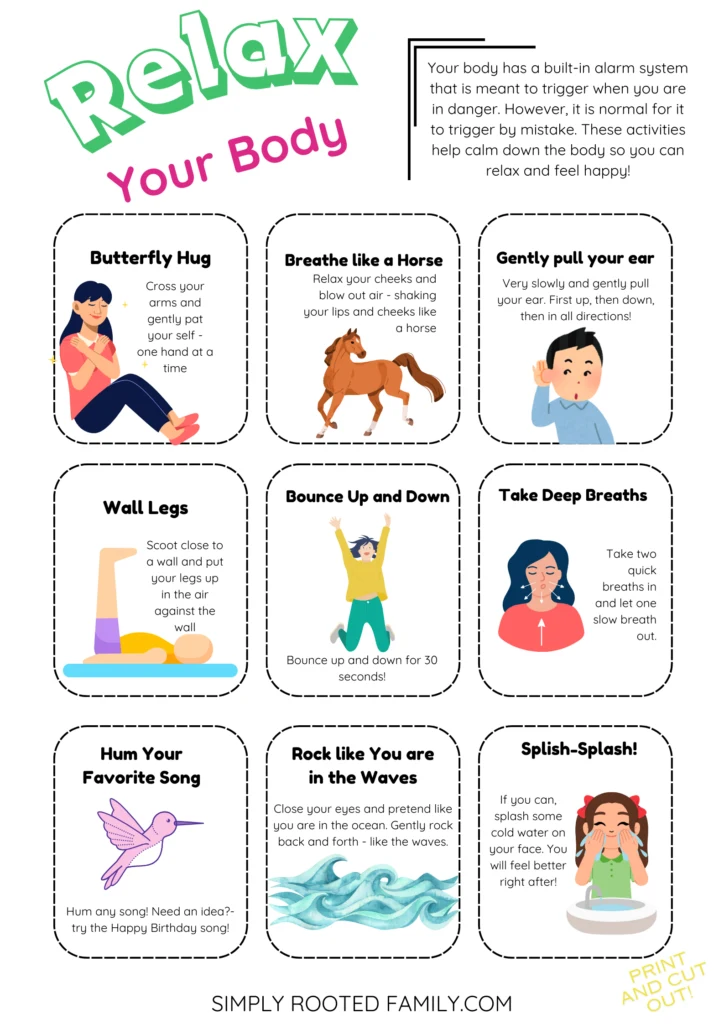These nervous system regulation activities help kids and adults move from fight-or-flight mode to a state of calm instantly. Let’s discuss the warning signs of a dysregulated nervous system and tips on how to regulate it within minutes.
Can your body not seem to tell the difference between being chased by a lion and having a messy kitchen?
Does your child react to being handed the wrong color cup as if their life was in danger?
There was once a time when humans needed this super reactive “fight-or-flight” mode to survive (think about cavemen days).
However, without the constant need for this beautifully crafted alarm system – our body can sound the panic alarm at all the wrong times.
The nervous system is the culprit. Luckily, you (and your children) can have full control over your nervous system when you learn what it happening and how to regulate it.
What is Your Nervous System?
Your nervous system is made up of your brain, spinal cord and nerves. It carries messages between your brain and the rest of your body.
Our nervous system has two pathways – parasympathic and sympathetic.
The parasympathetic nervous system pathway is responsible for “rest and digest” activities. When activated, this triggers salivation, slows breathing and heart rate, and other functions to help with relaxation and healing.
On the other hand, the sympathetic nervous system pathway is ready for action. It activates the heart, slows digestion (because you don’t need to worry about that when you are in immediate danger), triggers adrenaline.
Our body is like a well-oiled machine when it is functioning properly; however, it can take a turn for the worst when our nervous system becomes dysregulated.

You may also like: Anger Management Activities for Kids
Red Flag Signs of a Dysregulated Nervous System
A nervous system becomes chronically dysregulated when it is stuck in survival mode so often that your body is out of balance and these pathways simply stop working properly.
Warning signs of a dysregulated nervous system in children and adults include:
- Gut issues – such as diarrhea, constipation, or food intolerances
- Sensory sensitivities- bright lights or loud noises can be extra triggering
- Startles quickly – may seem extra jumpy or nervous
- Difficulty with concentration – trouble focusing, addiction to technology (for example: goes on phone at red lights or goes on tablet as soon as they come home from school)
- Irritably – not patient, easy to anger
- Develops chronic conditions from imbalances in the body
- Develops mental health issues like anxiety and depression
Some quick solutions for fixing nervous system issues include getting proper sleep and nutrition. But most people need additional support.
Check out these mindfulness activities – which also help calm an over action nervous system!
9 Nervous System Regulation Activities
Studies suggest 1 in 6 children (and many adults) struggle with a dysregulated nervous system.
These simple, quick activities can actually trick your body and remind your brain that you are, in fact, NOT getting chased by a lion.
Teach these to your children and print out the guide for them at the end!
1) Butterfly Hug
The butterfly hug method is a quick and easy way to trigger the parasympathetic nervous system (calm down the body).
Simply bring your hands to your chest and cross them at the wrist. When you curl your thumbs around each other you will see why this is called a butterfly hug.
Now, take turns gently tapping each hand. Tap twice with your left hand. Then, tap twice with your right hand.
Related: 5 Steps to Mindfulness (the Mindful Break Technique)

2) Two Breaths in – One Breath Out Method
There are many deep breathing techniques that can help calm the mind and body and support nervous system regulation.
I think this is a great one for children because it is easy to remember and do!
Just take two sharp breaths in (to fill the lungs) then let the air out slowly.
3) Horse Laugh
A horse breath or horse laugh is a fun way to stimulate the vagus nerve (a nerve that controls breathing, digestion, and heart rate) – which shifts into rest and digest mode.
To do this, mimic the reaction a horse has when it is excited. Relax your cheeks and lips. Blow your air out forcefully so that it wiggles and vibrates the cheeks and lips. You can even make the noise of a horse.
Related: Teach kids to calm down on their own with these nervous system regulation tips.
4) Gently Pull on Your Ear
Another way to stimulate the vagus nerve and quickly calm down is to very gently pull on the ear.
Slowly and gently pull on the outer edge of your ear, starting at the top and working your way down. You can gently massage the area behind your ear and your earlobes, too.
5) Hum a Song
When we hum a song, the vibration travels through the nasal cavity and sinuses, stimulating (you guessed it!) the vagus nerve. This shifts the body into a state of relaxation.
Hum your favorite song. If a child isn’t sure what song to hum, I tell them to hum the Happy Birthday song.
6) Jump Around
Bouncing, jumping, and rebounding are provides incredible sensory and overall health benefits for all of us.
The simple act of jumping grounds the nervous system and provides a calming effect.
Pair this with the calming effect of getting outside in nature and you will be relaxed in no time.
7) Wall Sit
A wall sit with legs in the air, also known as a “Legs Up the Wall” pose in yoga, promotes relaxation and vagus nerve stimulation.
Scoot up to any wall, lay flat on your back and raise your legs up against the wall.

8) Rocking
Rocking can help regulate the nervous system by releasing chemicals that promote peacefulness (endorphins) and reducing anxiety and improve mood.
Close your eyes, pretend like you are in the ocean, and gently rock back and forth or side to side.
9) Water or Cold Exposure
Another nervous system regulation tip is water or cold exposure, such as splashing some cold water on your face.
Short-term exposure to cold can stimulate the vagus nerve, which can help reduce stress and slow the heart rate. Cold exposure can also trigger the release of chemicals in the body that may help with pain, depression, and anxiety.
Print the below Relax Your Body Cards instantly here!

Final Thoughts on Nervous System Regulation
It’s easy to reign in your wild nervous system.
This knowledge coupled with these simple nervous system regulation activities helps adults and children manage their body and calm down effectively.
Remember, you are not being chased by a lion (usually at least), and you can calmly handle any issue that comes your way!
For more tips on raising kids who are healthy at home and strong in the world, follow us on Facebook.

